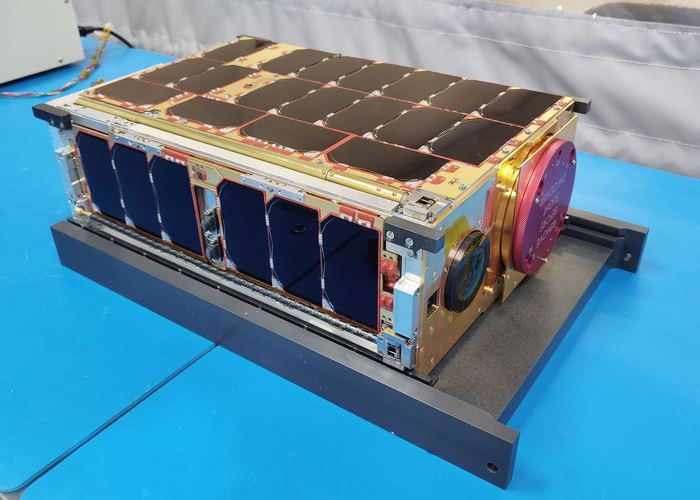UTD Science Instrument Travels to Space
11.28.2022
 The SPORT satellite is the size of two loaves of bread and will help scientists try to understand why plasma bubbles form in the ionosphere. (Photo credit Sydney Dahle/Utah State University)
The SPORT satellite is the size of two loaves of bread and will help scientists try to understand why plasma bubbles form in the ionosphere. (Photo credit Sydney Dahle/Utah State University)
On Nov. 26, a SpaceX Falcon 9 rocket ferrying supplies to the International Space Station also carried a small satellite containing a scientific instrument built by researchers at The University of Texas at Dallas.
The CubeSat nanosatellite – rectangular and about the size of two loaves of bread – is part of the CubeSat Launch Initiative and will be used to study the ionosphere, a region of the Earth’s upper atmosphere that is composed of electrons and other charged particles called plasma.
At night, dense blobs of plasma – like bubbles in a lava lamp – form in the ionosphere over equatorial and tropical regions. The bubbles create variations in the ionosphere. These variations, known as space weather, can interfere with radio waves and GPS signals that travel through the region, which can affect communications and navigation on Earth.
“When a radio signal passes through these bubbles, it gets scattered, or scintillated,” said Phillip Anderson MS’85, PhD’90, professor of physics and director of the William B. Hanson Center for Space Sciences at UT Dallas. “This occurs mostly around the equator and is a very serious problem. You can lose contact with communications satellites and with GPS satellites, which makes navigation unreliable. There is a lot of interesting physics behind these bubbles, but we don’t understand exactly how they are formed, and we can’t predict them.”
 Phillip Anderson MS’85, PhD’90, professor of physics and director of the William B. Hanson Center for Space Sciences at UT Dallas, explained that space weather can interfere with satellite communication.
Phillip Anderson MS’85, PhD’90, professor of physics and director of the William B. Hanson Center for Space Sciences at UT Dallas, explained that space weather can interfere with satellite communication.
Dr. Rod Heelis, who recently retired as center director and is now a UTD research scientist in space sciences, is a primary investigator on the mission. He and his colleagues built an ion velocity meter for the Scintillation Prediction Observations Research Task (SPORT) mission, which is a partnership between NASA and the Brazilian Space Agency. In addition to the UTD component, the CubeSat SPORT satellite contains five other scientific instruments built by U.S. university scientists and The Aerospace Corp.
UTD’s ion velocity meter measures the energy distribution and direction of movement of the ion plasma.
Once deployed by the space station, the satellite will fly through low regions of the ionosphere and collect data on conditions that lead up to plasma bubble formation and, ultimately, help scientists understand how they affect ground-based communications signals.
UT Dallas researchers at the Center for Space Sciences, part of the Department of Physics in the School of Natural Sciences and Mathematics, have built ion velocity meters for several other satellite missions to study the ionosphere, including the Communications/Navigation Outage Forecasting System satellite that was launched in 2008 and reentered the atmosphere in 2015; the Ionospheric Connection Explorer mission, launched in 2019; and the Scintillations Observations and Response of The Ionosphere to Electrodynamics CubeSat mission, which was deployed by the space station in 2020 and recently reentered the atmosphere.
–Amanda Siegfried
Tags: Dr. Phillip Anderson, NSM, Space Sciences